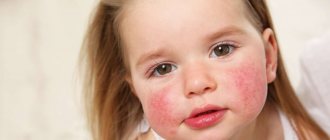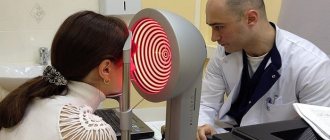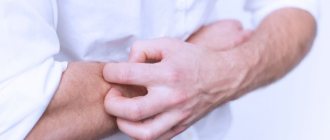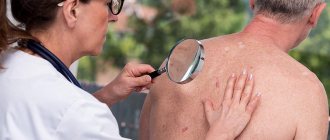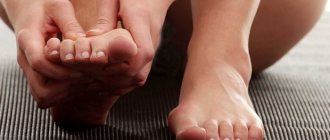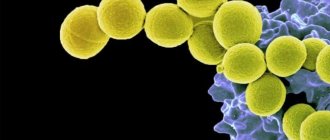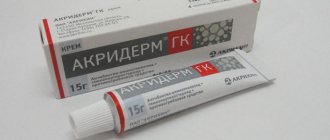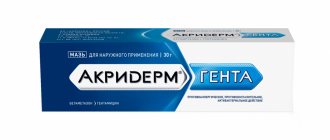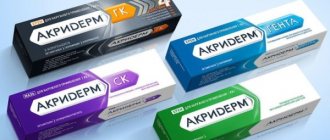The term “diathesis” in domestic medicine refers to a feature of the body’s constitution, which is expressed in a predisposition to certain diseases. Usually, diathesis refers to allergic diathesis, the most common and easily diagnosed. According to various sources, diathesis occurs in 30-75% of children.
Unlike allergies themselves, diathesis is not associated with functional disorders of the immune system. An allergic reaction during diathesis in infants is usually explained by the characteristics of the child’s body. In children of the first year of life, the protective function of the intestine is reduced: the intestinal walls are thin, the amount of enzymes and antibodies produced is small. As a result, the child’s body may not be able to cope with a large number of highly allergenic foods and give an allergic reaction. By two to three years, the amount of enzymes becomes sufficient, and diathesis in most cases goes away.
Allergic reaction
A negative reaction to any stimulus often worries infants. The introduction of complementary foods, breast milk, washing powder, cold or heat - all this can cause red spots on the body of a baby. It is divided into several types: reaction to food, dermatitis, urticaria, toxicerma and photodermatosis.
Food allergies
Food allergies occur much more often than others. Most products in the store contain hazardous substances (dyes, flavors). They are harmful even for adults, not to mention the fragile children’s body. Allergic skin rashes can also occur in infants if the mother does not follow a special diet. Experts recommend eating right and switching to artificial feeding as soon as possible.
Highly allergenic foods include eggs, chocolate, honey, tangerines, oranges and lemons, mushrooms, strawberries, and currants. However, in one child such food is well absorbed, while in another it easily provokes diathesis on the face. The presence of chronic and viral diseases, as well as intestinal dysbiosis and weak immunity can contribute to this.
Dermatitis
The disease is classified as a dermatological allergy, in which the child is bothered by flaky spots on the body, pain and itching. If the disease starts, the allergy on the hands in the form of red spots turns into large blisters that spread to the whole body. Over time, they increase in size, burst, leaving behind weeping ulcers and suppuration.
Hives
Another type of dermatological allergy, but has different symptoms. With this disease, small red blisters with a clear outline appear on the body. You may notice that the spots rise several millimeters above healthy skin.
The plaques are very itchy, cover most of the area, and often merge into large lesions. The main causes of allergic spots on a child’s body are: medications, food, parasites in the body, cosmetics, jewelry or materials from which clothing is made. Doctors say that the disease almost never occurs in babies under 6 months of age. However, the older the child, the higher the likelihood of developing the disease.
Sakania Luiza Ruslanovna
Dermatovenerologist, cosmetologist, trichologist
Ask a Question
Urticaria has the ability to become chronic and occur periodically throughout life, so it is important to treat it. In addition, the chronic type often accompanies people with gastrointestinal diseases and leukemia.
Photodermatosis
One of the rarest types of allergic reaction that occurs to sunlight. According to experts, children under three years of age suffer from the disease. Factors that cause red raised spots on the body include:
- viral infections;
- heredity to allergies;
- presence of chronic diseases;
- long-term use of antibiotics.
The allergy appears on the body in the form of pinkish plaques some time after exposure to the sun. In addition, the child suffers from watery eyes, swelling of the face or other exposed areas of the body.
Toxidermy or toxicoderma
The most severe type of allergy throughout the body in a child, causing inflammatory processes on the skin and mucous membranes. Toxidermy includes several types, but most often it is food and drug. Symptoms directly depend on the severity and duration of contact with the irritant.
Usually, severe itching and red spots on the body first appear, then papules form on the itchy areas. There are signs of general intoxication of the body: high fever and rash, nausea or vomiting, weakness, chills. In severe cases, angioedema develops, which can be fatal.
The most common dermatitis in children: features of diagnosis and therapy
According to foreign researchers, approximately 25% of all visits to doctors are complaints about skin pathology [1]. Among them, the most common dermatitis in children is seborrheic, contact (diaper) and atopic. In recent years, scientists have noted an increase in the incidence of these skin diseases in general practice. Thus, in the Netherlands, during the period 1987–2001, doctors most often diagnosed fungal (dermatophytoses), atopic, bacterial (impetigo) and contact dermatitis in children aged 0–17 years, which accounted for 57% of all cases of skin diseases [2].
Seborrheic dermatitis. The fungus Malassezia furfur is considered a possible etiological factor for seborrheic dermatitis. These microorganisms usually colonize healthy skin, but they also play an important role in the etiology and/or exacerbation of folliculitis, seborrheic and atopic dermatitis.
There are two clinical forms of the disease: seborrheic dermatitis of infants and seborrheic dermatitis of adults.
Seborrheic dermatitis affects 10% of boys and 9.5% of girls; more often - children aged the first 3 months of life, then the incidence decreases slightly (by 2 years it usually goes away or persists until 4 years of age). In adults, seborrheic dermatitis is diagnosed at any age: the rash is represented by red itchy papules covered with scales, on the scalp it resembles dandruff.
In infants suffering from seborrheic dermatitis, already at the 2-3rd week of life, accumulations of fatty, sebaceous scales (gneiss) appear on the skin of the scalp (to a lesser extent on the forehead, cheeks, in the folds behind the ears), and in cases of damage to large folds of the skin of the body and extremities - a maculopapular rash, also covered with scales on the periphery. The rash can also be localized in the area of the external auditory canal and sternum, on the neck, in the axillary and groin areas. Itching is moderate or absent [3]. When the rash is localized in the diaper area, a bacterial infection may occur, which sometimes makes treatment very difficult. If left untreated, the rash may spread to other areas of the body, becoming generalized. Against the background of seborrheic dermatitis or after its disappearance, some children develop another dermatitis - atopic, in the etiopathogenesis of which (especially the severe form of the disease) Malassezia furfur also plays a very significant role.
Important distinguishing signs of seborrheic dermatitis are the absence of itching of the skin, as well as the predominant lesion of the scalp and diaper area in children suffering from seborrheic dermatitis. Atopic dermatitis is characterized by skin exudation, while seborrheic dermatitis is characterized by an earlier onset and the absence of a hereditary burden of atopy (Table 1).
Treatment of seborrheic dermatitis is not particularly difficult. Manifestations of the disease in the scalp in newborns (milk crusts) can spontaneously go away by the 6-8th week of life (or for such children it is enough to prescribe daily washing of the hair with a special shampoo, followed by the application of mineral or olive oils). They also cleanse irritated skin with areas of hyperseborrhea, especially in problem areas. For this purpose, the use of cleansing gel “Bioderma Sensibio DS”, “Saforel” is recommended, “Topicrem” is also recommended, shower gel foam is for skin prone to mycoses, “Friderm Zinc” (for flaking of the scalp).
After preliminary cleansing, the skin is dried and a dermatological cream (for example, Bioderma Sensibio DS) is applied to problem areas (in newborns and children - scalp, forehead, buttocks; in adults - wings of the nose, eyebrows, chin).
Of the dermatological shampoos specially designed for the treatment of seborrheic dermatitis in children and adults, Nizoral shampoo containing 2% ketoconazole is widely used. However, the same clinical improvement in a comparative study was noted with the use of Kelual DS shampoo, which has fungicidal, fungistatic, anti-inflammatory and keratoregulating effects due to the content of the non-imidazole antifungal drug ciclopiroxolamine (D. Shuttleworth et al., 1998). Cyclopiroxolamine has a high coefficient of fungistatic action (suppression of proliferation of Malassezia fungi); in addition, it has a unique anti-inflammatory effect, comparable even to the effect of a mild corticosteroid (K. Gupta, 1998). The composition of the Kelual DS shampoo also includes another antifungal drug - zinc pyrithione 1%, which has a fungistatic and kerator-reducing effect. The combination of two antifungal active components has a synergistic effect in suppressing the proliferation of Malassezia fungi, which is reflected in the high coefficient of fungistatic action in the Kelual DS shampoo, which, as the study has shown, is superior to the inhibitory activity of ketoconazole. Additionally, the Kelual DS shampoo contains keluamide, which has a mechanical dispersive effect, ensuring rapid elimination of squams (keratolytic effect).
In case of the formation of seborrheic crusts on the head and severe peeling of the skin, you can also use the Friederm Tar shampoo, Mustela Stelaker Cream (apply it to seborrheic crusts in children, leave it overnight and then wash it off with Mustela Bebe Foam Shampoo for newborns).
Typically, medicated shampoos are used 2 times a week, the course of treatment is 6 weeks.
Other nonpharmacologic approaches (eg, limiting the use of hair sprays and gels, exposure to sunlight) may also be helpful in older children and adolescents.
For seborrheic dermatitis, topical corticosteroids should be avoided as first-line treatment [4]. Recently, a report appeared on the high therapeutic activity of the combined use of antifungal shampoo (ketoconazole) and the topical calcineurin inhibitor tacrolimus (currently in Russia this series of non-steroidal anti-inflammatory drugs is represented only by Elidel cream (pimecrolimus 1%)) [5].
In recent years, Malassezia furfur has been considered not only as a trigger factor for atopic dermatitis in children and adults, but also as one of the causes of severe recurrent course of the disease, refractory to traditional therapy. Also, these microorganisms are more often detected in this variant of atopic dermatitis, when the skin process is localized on the head, neck and chest area (in the English literature, the so-called head and neck dermatitis - “dermatitis of the neck and head”).
Atopic dermatitis. Spergel and Paller provide the following clinical criteria for atopic dermatitis [6].
Mandatory criteria:
- itching;
- eczematous changes: chronic or recurrent; the most age-specific patterns involve the face, neck, and extensor surfaces of the extremities in infants and children; Damage to the flexor surfaces, especially in older children and adults, is less pronounced in the groin and axillae.
Important features in favor of this diagnosis (not found in all patients):
- onset of the disease at an early age;
- xerosis;
- atopy (IgE reactivity).
The diagnosis of atopic dermatitis can be made after excluding diseases such as scabies, allergic contact dermatitis, seborrheic dermatitis, psoriasis and ichthyosis.
As practice shows, atopic dermatitis is characterized by clinical polymorphism. Suffice it to say that the literature describes more than 26 separate locations of the skin process on parts of the body and nine typical signs of the disease, the main of which, in combination with dry skin, are three: itching, erythema, papules. However, the location of skin lesions often depends on age. Thus, in infancy (the onset of the disease before 2 years of age) the cheeks, face, neck, and outer surface of the limbs are affected. In the age period from 2 to 10 years, rashes are usually localized in the elbow and popliteal folds, on the back, back of the neck, and lateral surfaces of the torso. Adolescents and adults are characterized by damage to the face (mainly periorbital or atopic cheilitis), the dorsum of the hands, and in the area of the elbows and knees. Itchy papules are located against the background of lichenized and dry skin, often with pronounced peeling.
Today, external therapy is recognized as the most important, pathogenetically substantiated and absolutely necessary for every patient with atopic dermatitis, which includes proper skin care (cleansing/moisturizing/softening) followed by the application of anti-inflammatory drugs to it. According to the American prof. D. Leung, “moisturizing and softening the skin are key in the treatment of atopic dermatitis” [7]. Moreover, due to impaired barrier function and dry skin, moisturizers/emollients should be used even during periods of the disease when there are no symptoms [7, 8]. This approach is based on scientific data: in particular, in patients with atopic dermatitis, the same inflammatory cells that infiltrate the lesions are found in unaffected areas of the skin; in addition, the manifestations of skin hyperreactivity and xerosis in different areas of the skin are no different [7, 8]. Because of its hyperreactivity, atopic skin has the ability to change depending on fluctuations in air temperature, stressful situations, after eating certain foods, or for other unknown reasons. The condition of the skin also changes after applying external medications; Sometimes patients or doctors themselves can associate symptoms such as burning, increased itching, hyperemia with the external agent used, which often leads to discontinuation of the drug. In fact, the cause may be the above exogenous factors. If necessary, the doctor conducts a drug tolerance test on the patient. Rare cases of the development of allergic contact dermatitis even to the main anti-inflammatory drugs for the treatment of atopic dermatitis (topical corticosteroids or topical calcineurin inhibitors) have been described. Another feature of atopic skin is that its dryness, accompanied by transepidermal water loss, increases the systemic absorption of external hormonal agents and, consequently, their side effects [9].
Accordingly, effective treatment of dry and itchy skin may improve treatment outcomes for atopic dermatitis. However, it is impossible to influence such causes of dry skin as changes in the stratum corneum, disturbances in keratinization, the composition of the balance and amount of intracellular lipids, metabolism of transepidermal water, changes in skin pH, etc. simply by applying moisturizers and/or emollients to the skin. These are very complex physicochemical, biochemical and pathophysiological processes that occur differently in skin diseases. Recently, scientists have been considering dry skin in atopy from the point of view of a unified pathophysiological concept “atopy, dry skin and the environment” [10, 11]. Recognizing the importance of this approach, the dermatocosmetic lines “A-Derma”, “Dardi Lipo Line” were created, as well as a new unique emollient, which is used with great success in the treatment of atopic dermatitis abroad - “MAS063D” (Atopiclair) [12, 13]. Thus, according to Abramovits et al., in 94% of patients with mild to moderate atopic dermatitis, the need for topical corticosteroids completely disappeared within 50 days after using the non-steroidal hydrolipidic cream “MAS063D” (Atopiclair) [13].
The unique line of products “A-Derma” (“Egzomega”) uses the exceptional qualities of the oat extract of the Realba variety: amylose, amylopectin and β-glycans included in “Egzomega”, coming into contact with water, form a moisturizing and protective film on the surface of the epidermis . In addition, they promote the retention of lipids, polyphenols and proteins, forming a micelle “reservoir” that releases active substances as needed and provides prolonged action; proteins have an anti-inflammatory effect; phospholipids and glycolipids nourish and moisturize the skin; polyphenols have antiradical and anti-inflammatory effects; magnesium, iron, copper, zinc, manganese are protein cofactors. Egzomega products also contain essential omega-6 fatty acids and vitamin B3, which ensures the restoration of the structure and barrier function of the skin.
To care for the skin of patients with atopic dermatitis, other products from the medical and cosmetic series such as “Aven”, “Mustela Stelatopia”, “Uriage”, “Vichy”, etc. are also widely used.
Before using emollients/moisturizers, a patient with atopic dermatitis should comply with certain skin care conditions (cleansing with special hygiene detergents, using dechlorinated water, etc.). Moisturizers/emollients are applied after preliminary cleansing of the skin using medicated skin care products - usually the same line of medicinal cosmetics (Topicrem Bodygel, BioEcolie; Mustela Stelatopia, washing cream; Egzomega - cleansing shower oil for atopic skin, etc.).
In case of persistently recurrent course, as well as moderate and severe forms of atopic dermatitis, patients are advised to use medicinal cosmetics containing additional anti-inflammatory (for example, alphabisabolol, allantoin, dexpanthenol, etc.) or antifungal substances (for example, “Topicrem” gel - foam for body skin prone to mycoses, which contains piroctone olamine 1%).
In particular, the use of the Topicrem cosmetic line is recommended (Table 2).
The Dardia Lipo Line treatment products include natural hydrophilic substances - lactate, urea and glycerin, while cetearylethyl hexanoate and a mixture of medium chain triglycerides maintain the lipid balance of the skin. The combination of these components leads to the achievement of the best results in the maintenance therapy of allergic dermatoses, preventive skin care after the use of topical corticosteroids, chemotherapy and radiation, as well as in daily skin care. The water-fat and anhydrous forms of the products in this line are ideal for dry and very dry skin, are easily absorbed and evenly distributed over the skin (Table 3).
It has been proven that the effectiveness of moisturizers/emollients depends on the dose (they should be used regularly in sufficient quantities), skin pH, and also on patient compliance [7, 8, 12, 13]. It is especially important to use them before applying anti-inflammatory drugs to the skin (topical corticosteroids, topical calcineurin inhibitors). There are even cases in the literature of equivalent effectiveness of moisturizers and topical corticosteroids in patients with atopic dermatitis. In general, skin hydration and moisturizers significantly increase the effectiveness of complex therapy for atopic dermatitis and the quality of life of such patients. In addition, moisturizing preparations have a kind of preventive effect even before the appearance of pronounced symptoms of exacerbation of the disease and can significantly reduce the amount of drug therapy. At the same time, they do not replace topical drugs that have an anti-inflammatory effect.
Modern practice shows that the importance of using moisturizers in the treatment of atopic dermatitis is significantly underestimated throughout the world. Thus, a recent survey showed that of 77% of children suffering from atopic dermatitis to whom specialists prescribed emollient ointments, only 21% used them immediately after washing [14].
The goal of the treating physician and nurses is to instruct patients with atopic dermatitis and their caregivers to regularly cleanse and hydrate the skin, followed by the application of an anti-inflammatory drug if necessary.
Sometimes in children under one year of age, the diagnosis of atopic dermatitis presents certain difficulties, especially if the skin manifestations are localized in the diaper area. Diaper dermatitis almost always occurs in the buttocks area. The disease is associated with factors such as the immaturity of the protective mechanisms of the child’s skin, its mechanical damage (friction from diapers) and chemical irritation from urine and feces. Depending on the severity, the clinical manifestations of diaper dermatitis can vary from mild skin erythema of varying prevalence to the appearance of papules, erosions and infiltrates in the skin folds. Severe diaper dermatitis is characterized by the appearance of conflicts, then erosions and crusts on the surface of the papules.
In some children suffering from diaper dermatitis or seborrheic dermatitis, signs of atopic dermatitis can also be detected at the same time.
In the treatment of diaper dermatitis, the use of medicinal hygiene products is justified (Bepanten, Topicrem ultra-moisturizing emulsion, Mustela Stelkactive diaper cream, etc.), which are applied only after preliminary cleansing of the skin with special hygiene products. Air baths are important. The use of topical corticosteroids in the treatment of diaper dermatitis is unjustified. In addition, when prescribing a topical combination drug, the doctor must be sure of its necessity, i.e., correctly determine the indications for its use. Thus, according to American researchers, if a child has diaper dermatitis, most doctors considered it more appropriate to use a combination drug consisting of a strong class topical corticosteroid (Betamethasone valerate) and an antifungicide (clotrimazole), explaining this by the fact that the basis of diaper dermatitis is candidiasis and inflammatory mechanisms [15]. At the same time, doctors forgot that this topical corticosteroid is contraindicated for use in children under 12 years of age. Moreover, as another study showed, every second pediatrician (56%) prescribed a similar drug to children aged 0 to 4 years [16].
The International Expert Group on Atopic Dermatitis (2006) recalls that in adult patients with atopic dermatitis, a combination of atopic, contact and irritative dermatitis may be observed, and atopic dermatitis involving the hands and feet should be differentiated from psoriasis of the palms and soles and fungal skin lesions [8 ]. It is also necessary to remember about such rare pathologies in children as genodermatosis - Neferton syndrome; in adults and children - vitamin deficiency, malignant skin tumors. Thus, mycosis fungoides, by the nature of the skin lesions and the presence of intense itching, may be similar to the common form of atopic dermatitis, however, mycosis fungoides appears in adolescence and adulthood [7, 8].
For questions regarding literature, please contact the editor.
D. Sh. Macharadze , Doctor of Medical Sciences, Professor of RUDN University, Moscow
Insect bites
Almost always, bites of various insects (wasps, mosquitoes, fleas, ticks) are accompanied by spots. In the first minutes or hours after contact with the pest, the blisters on the child’s body itch and hurt, but gradually all unpleasant symptoms disappear. The difference from allergies is isolated redness on the skin only in those places where the insect has bitten.
If you know for sure that your child was bitten by a mosquito or a bee, then there is no need to see a doctor. As a rule, all unpleasant symptoms will disappear within 24 hours; you can lubricate the red round spot on the body with bite ointment. If you develop signs of an allergic reaction (inflammation, difficulty breathing, swelling of the larynx or face), you should immediately seek medical help.
Stork spot. What is it and why is it formed?
In the medical literature, the stork spot has a completely non-fairy-tale scientific name: nevus of Unna or simple nevus. It can be located not only on the back of the head or on the back of the neck, but also on the baby’s forehead and eyelids. In this case, it is called “the kiss of an angel.”
One may come across the opinion that these spots are a consequence of a traumatic birth, in which the child’s head was compressed for a long time, but scientists refute this. They say that a simple nevus is formed in utero. It is formed due to a failure in the formation of blood vessels: in this area they are slightly dilated and the blood flow in them is increased, so the skin here is more pink. Another version is that the stork spot is formed in the place where the baby’s head is pressed to the mother’s sacrum in the later stages. Due to pressure, the capillaries expand and a spot is formed: have you ever woken up with red marks from a pillow on your face? It's about the same here.
Be that as it may, almost half of babies are born with a simple nevus on the face. There is no need to be afraid of him. This is not a disease. It is not the mother’s fault that the child is born with a mark on the back of the head, and she cannot prevent its appearance in any way.
Infectious pathologies
Many diseases can cause red pimples and blemishes on the body. The most common are chickenpox, measles and rubella. However, the development of more rare diseases is possible, so if you notice a rash on the skin in the form of blisters, you should definitely consult a doctor.
Chicken pox
A childhood disease with skin rashes, most of the population experiences chickenpox in preschool age. The body of the sick person becomes covered with red spots, which then turn into blisters. The baby is worried about fever, weakness, nausea and itching. Often the symptoms are accompanied by redness of the throat and disturbances in the gastrointestinal tract. The disease begins with a rash on the cheeks, between the fingers and armpits, then spreads to the whole body.
Measles
The viral rash is transmitted by contact with an infected person and remains dangerous for up to 5 days. Some time after infection, signs of a cold appear (fever, runny nose, cough, lacrimation), but soon large red spots form on the body. They are characterized by an irregular shape, are localized on almost all parts of the body at once, peel off and acquire a brownish tint.
Scarlet fever
Red, rough spots on a child’s skin and a sore throat indicate the onset of scarlet fever. You can become infected through airborne droplets or through household contact. Epidemics often occur in kindergartens, as the disease is transmitted through toys, dishes, and clothes. If one child becomes ill, it is recommended to strictly observe precautions and isolate other children. Many mothers are interested in: is it possible to bathe a child with scarlet fever? In the first 5-7 days you should refrain from taking a bath; it is better to use wet wipes.
Rubella
With rubella, red pimples on the child’s body do not appear immediately, but only a week after other signs appear. A mild sore throat, lacrimation and conjunctivitis signal the onset of the disease.
Usually body temperature remains within normal limits or rises to 37 degrees. Like all infectious diseases, rubella spreads quickly, so isolation is necessary. Childhood illnesses are very similar, so it doesn't hurt to familiarize yourself with the signs. It is through them that you can notice the disease in time and consult a doctor.
| Signs | Measles | Rubella | Scarlet fever |
| Initial symptoms | Intoxication, which intensifies within 2-3 days, signs of a cold | Rashes on the body, catarrhal phenomena | Chills, fever, intoxication of the body, signs of acute tonsillitis |
| When does the rash appear? | Not earlier than 4 days | On the first day of illness | For 1-2 days |
| What do rashes look like? | Large spots, papules | Small reddish spots | Small red dots |
Roseola
Rashes on the skin in the form of red spots, characterized by an obligatory increase in temperature. It gradually decreases (high levels can remain up to 4 days), but the body continues to be covered with plaques. The disease is caused by type 6 herpes virus, which requires mandatory therapy.
Will the spot on the back of my head go away on its own?
A simple nevus is the most harmless deviation in the formation of skin capillaries. During the first year of the baby's life, the spot begins to lighten until it matches the color of the normal skin tone. It may still appear for some time after intense screaming or severe stress, and by the age of two it usually goes away. But if we talk specifically about the stork spot - a simple nevus located on the back of the head or back of the neck - then it may not completely disappear, but only turn pale. Fortunately, since it is not located in the most visible area, the damage to the exterior is minimal.
When to see a doctor
Having noticed a red rash on a child’s body, there is no need to rush to go to the hospital on your own. If you suspect an infectious disease, you must call a doctor at home so as not to infect others in public places. You should urgently call an ambulance if you experience the following symptoms:
- impaired breathing, wheezing, chest pain;
- fainting, difficulty speaking, or confusion;
- the appearance of watery pimples on the body, which bring severe discomfort to the child;
- a sharp increase in temperature, as well as the ineffectiveness of antipyretic drugs;
- anaphylactic shock, in which blood pressure drops, breathing becomes difficult, and signs of a severe allergic reaction appear.
Before a specialist arrives, you should not treat red spots on your child’s body with anything, be it a soothing cream, brilliant green or iodine. Such measures will blur the clinical picture, which means the doctor will not be able to make the correct diagnosis and tell how to treat the disease.
Treatment methods
Therapy depends on the cause of the red rash in the child. You should definitely visit a pediatrician, and if you suspect skin pathologies, a dermatologist. Do not squeeze, open or scratch small red dots on the body. This makes it easy to get infected, and the wounds will leave unsightly marks. Children should not be given medications without a doctor’s prescription; it is only permissible to use antiallergic drugs.
Fenistil, Tavegil, Claritin, as well as Gistan ointment are used against allergies in the form of red, rough spots on the body of infants. In advanced cases, you should choose hormonal drugs: Elokom or Advantan.
A red rash on a child’s face after frost can be eliminated with La-Cri cream, which soothes and heals the affected epidermis. Creams such as Depanthenol, Bepanten and Panthenol have an anti-inflammatory and restorative effect. It is recommended to lubricate the small red rash on the dermis during chickenpox with brilliant green and zinc ointment. In all other cases, consultation with a doctor and his supervision during treatment with medications are necessary.
Precautionary measures
To protect your child from infectious diseases and other ailments, it is necessary to strengthen the immune system. The body’s protective function can overcome many diseases; to maintain it, it is recommended to regularly give the child vitamin complexes.
It is important to protect your baby from factors that provoke red dots on the skin: junk food, dangerous insects, crowds of people where you can get a serious infection.
Skin rashes in children are not uncommon, but you can’t turn a blind eye to red dots. There are many reasons for the development of small pimples on the body: from a mosquito bite to an infectious pathology. You should definitely make an appointment with a doctor or call him at home if you suspect an airborne disease. You cannot choose a treatment regimen on your own; many diseases have serious consequences, so therapy should be carried out under the supervision of a specialist.
You can ask your question to our author:
